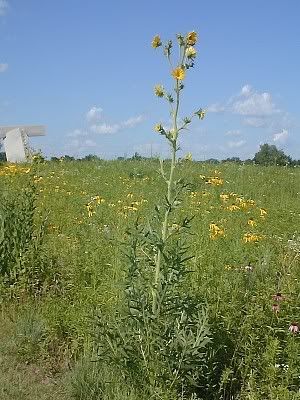Native plants. A change of pace. - 08/09/08 12:06 AM
I thought I'd throw you all a little curve ball, and start a thread about native plants. If you get a chance sometime, post a picture and brief description of a terrestrial plant that is found around your pond. Something special to your region and climate would be nice.
Here's my effort.
Compass plant. Silphium laciniatum
Pond Boss forum member Norm Kopecky provided my oldest daughter with a bag of seeds he collected. My daughter excitedly broadcast the seeds in an area where fill material was placed from construction of my Dad's pond. Norm told us that by the third year we would have some results.
He was right.
This is the third year and we have learned the following about this plant.
It is native to the tallgrass prarie. It can grow to nearly ten feet tall. Note the second picture--the leaves always align themselves in a north-south axis. We now have about fifty plants and every one of them was lined up this way. This plant can also live for 100 years. The resin of this plant was used as chewing gum by Native American children.



Here's my effort.
Compass plant. Silphium laciniatum
Pond Boss forum member Norm Kopecky provided my oldest daughter with a bag of seeds he collected. My daughter excitedly broadcast the seeds in an area where fill material was placed from construction of my Dad's pond. Norm told us that by the third year we would have some results.
He was right.
This is the third year and we have learned the following about this plant.
It is native to the tallgrass prarie. It can grow to nearly ten feet tall. Note the second picture--the leaves always align themselves in a north-south axis. We now have about fifty plants and every one of them was lined up this way. This plant can also live for 100 years. The resin of this plant was used as chewing gum by Native American children.


